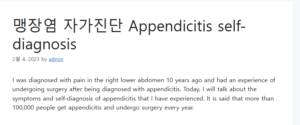I was diagnosed with pain in the right lower abdomen 10 years ago and had an experience of undergoing surgery after being diagnosed with appendicitis. Today, I will talk about the symptoms and self-diagnosis of appendicitis that I have experienced. It is said that more than 100,000 people get appendicitis and undergo surgery every year.
Appendicitis – Thumbnail
thumbnail
Appendicitis (appendicitis)
appendicitis causes
The exact cause of appendicitis is still unknown. There are several hypotheses, from the story that chewing sand or eating hair causes appendicitis, but among them, the hypothesis that bacteria in the intestine cause inflammation in the appendix mucous membrane, and the hypothesis that bacteria enter the blood and cause inflammation when suffering from pharyngitis or pneumonia are the most popular. It’s a strong situation. 맹장염 자가진단
The exact cause of appendicitis has not yet been identified, but it is known that appendicitis occurs when the entrance to the appendix, that is, the opening, is blocked.

body-organs 좋은뉴스
Leader
appendicitis symptoms
1. Right lower abdominal pain
95% of people with symptoms of appendicitis feel right lower abdominal pain. In the beginning, the pituitary gland or upper stomach hurts, but as time passes, the pain moves to the lower abdomen. As the pain goes down little by little, people experience symptoms similar to indigestion and reflux esophagitis, causing confusion.
pain in the appendix
ache
2. Low fever, chills, tremors
Early symptoms of appendicitis include low-grade fever, sobbing, and tremors. According to the research results, if you have a slight fever between 38.5 and 39 degrees and have abdominal pain that makes it difficult to stand still, the possibility of appendicitis is very high. If pain persists in the right lower abdomen with a fever, it is better to be diagnosed early and receive appropriate treatment.
3. Bowel-related symptoms
Even if you have a bowel movement differently than usual, there is no cool feeling, and in severe cases, you may feel a residual feeling. In addition, it is difficult to pass gas, and some people may have persistent diarrhea.
sudden abdominal pain
colic
Appendicitis self-diagnosis
In case of acute appendicitis, the only treatment is ‘surgery’, so it is important to visit the hospital in time after self-diagnosis. Therefore, it is very helpful to know how to self-diagnose appendicitis on a daily basis.
In the beginning, the pain is felt in the pit of the stomach, and as time passes, the pain moves to the right lower abdomen.
I feel like I’m in the middle of the day, and I feel like I’m going to have a good time.
When I cough or walk, I feel a pulling sensation in my right lower abdomen and feel pain at the same time.
If you do not move and take a crouching position, the pain is greatly reduced.
The pain gets worse when you press your right lower abdomen with your hand.
The pain is so severe that it is impossible to repeat the act of bending and straightening the knee.
Sudden right flank pulling and pain often occur.
abdominal pain
heartache
Precautions after appendicitis treatment
There are some things to be aware of after appendicitis treatment through surgery. Depending on the degree of inflammation after surgery, there may be slight differences, but in mild cases, you can drink water from the next day after surgery. If the conditions are good, you can even eat right here. However, if inflammation is severe or peritonitis is caused through appendicitis, you should delay the start of intake of both water and food.
Today, we learned about the symptoms of appendicitis, how to self-diagnose, and precautions after treatment. If you suspect acute appendicitis through self-diagnosis, please do not eat or drink water and get a diagnosis quickly.